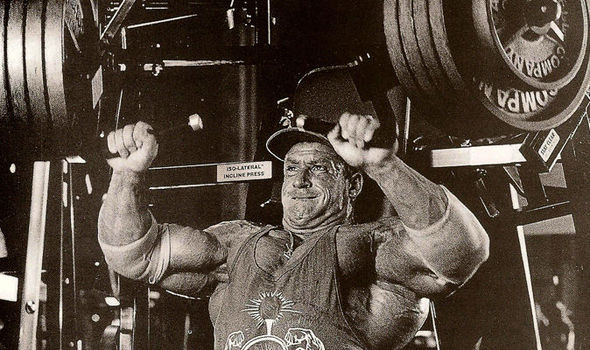Introduction
Intensification methods involve any training strategy designed to push a muscle past failure. This includes drop sets, rest-pause sets, cluster sets, forced negatives, and anything else that causes tears to stream down your face. These methods can be great ways to increase the amount of stimulating reps you perform in a workout, just don’t do them all of the time. Performing these too often can cause serious muscle damage that can impair your ability to lift in your next workout (2) – which essentially defeats the purpose of working out.
With that in mind, throw these methods in whenever you feel the need to spice things up. You can perform an intensification method on the last set of every exercise in a workout or just the last few exercises in a workout – it entirely depends on your goals and your training level. Add one of these in for a week straight at the most and give it at least a week or two before you try another one. Using intensification methods is a great way to add variation to training, but if you constantly use them, then they’re no longer a form of variation. Let that one sink in for a second…
Regardless, let’s get into the most common intensification methods and the theories behind how they can help growth. It’s worth remembering that there is little research on intensification methods as literally no one besides bodybuilders cares about maximizing muscle growth. Therefore, study funding is non-existent for interventions that cause, “skin-splitting pumps,” etc.
Drop Sets
 A drop set can be performed by beginning with a weight you can do for 10-12 reps. Perform your 10-12 reps, immediately strip an even amount of weight off each side of the bar or machine (or go to a lighter dumbbell), then go again for as many reps as you can do. You can perform another drop if you’re feeling frisky, but I don’t see the need to do more than 2 or 3 drops total in a single set. Dropping all of the way to 5-lb dumbbells on a curl or something is really just a waste of time for veteran bodybuilders.
A drop set can be performed by beginning with a weight you can do for 10-12 reps. Perform your 10-12 reps, immediately strip an even amount of weight off each side of the bar or machine (or go to a lighter dumbbell), then go again for as many reps as you can do. You can perform another drop if you’re feeling frisky, but I don’t see the need to do more than 2 or 3 drops total in a single set. Dropping all of the way to 5-lb dumbbells on a curl or something is really just a waste of time for veteran bodybuilders.
I’d recommend doing drop sets with machines or isolation exercises as it can be tough with compound barbell movements. You’ll need a spotter and another helper to assist in stripping the weight off of the bar as fast as possible. Having friends in today’s world is tough so I don’t imagine everyone has two people willing to help them do drop sets in a workout. Barbell compound movements can also obviously be dangerous if performed to failure multiple times so if you don’t have a spotter, I definitely wouldn’t recommend doing it. I’ve been there before – I rolled a 250-lb bar down my torso after doing a set to failure on bench without a spotter. 0/10 recommend it.
You can also perform mechanical drop sets in which the weight stays the same, but you adjust the mechanical advantage throughout the movement. This could be something like going from lying overhead extensions, to skullcrushers, and then to chincrushers to roast your triceps. Or you could even change your foot position throughout a leg press set, moving from the bottom, to the middle, and lastly, to the top of the sled as you get more fatigued. These can be a great option for people who train alone and don’t feel like stripping all kinds of weight between by themselves between drops.
Is there any Science behind Drop Sets?
A lot of people like to say that there’s no scientific evidence for drop sets, and that can certainly be true. We have studies that show that using drop sets in a longitudinal training program offers no additional benefits for strength or size compared to traditional training (1). However, this resonates with our comment in the Introduction – if you’re constantly doing drop sets, they no longer count as a variation in your training and will not really provide an additional stimulus!
On the other hand, studies show that adding drop sets to your training as a way to induce variation can boost growth. One particular study found that adding drop sets in the last 4-weeks of a 10-week program resulted in greater growth than a group performing the same program the entire 10-weeks (3). Therefore, it’s important to understand that drop sets can be useful, but you have to use them the right way to get the most bang-for-your-buck.
Lastly, many studies on drop set training match volume between traditional or drop set training sessions (11). That doesn’t exactly align with the reasoning behind performing drop sets, so not every single study done on drop sets applies to real world training.
Rest-Pause Sets
 A rest-pause set is a set in which you stick with the same weight throughout the set but you take small 10-20 second breaks to get more reps in. Say you start at a 10RM weight, perform your 10 reps, rest for 10-20 seconds, then try to squeeze out a few more reps. You can probably do this sequence 2-3 times but by the last time you’ll be lucky to get one rep in and you’ll be gasping for air if you’re like me. I like these for compound barbell movements as opposed to drop sets, especially when training alone. As with any intensification method, it’s still imperative to have a spotter around for when you pass out in your last set.
A rest-pause set is a set in which you stick with the same weight throughout the set but you take small 10-20 second breaks to get more reps in. Say you start at a 10RM weight, perform your 10 reps, rest for 10-20 seconds, then try to squeeze out a few more reps. You can probably do this sequence 2-3 times but by the last time you’ll be lucky to get one rep in and you’ll be gasping for air if you’re like me. I like these for compound barbell movements as opposed to drop sets, especially when training alone. As with any intensification method, it’s still imperative to have a spotter around for when you pass out in your last set.
Rest pause sets are also common in powerlifting in which a lifter can start with a 2 or 3RM weight. Perform a single, rest 15-20 seconds, then do another single and repeat for as long as you can. This can grab you anywhere from 5-10 reps at a super heavy weight within a period of 2-3 minutes. That’s density AND intensity. Some may also refer to this as cluster training, so pick and choose your definitions wisely – social media will tear you apart, regardless. Cluster training/heavy rest-pauses have been shown to be a great way to get more heavy reps in during a workout (6), so this method is always worth a shot as well.
Is there any Science behind Rest-Pause Sets?
Using rest-pause sets has been shown to be more effective for building muscle groups in the lower body compared to normal training whereas upper body results are similar between methods (10). This might be due to the fact that the extreme fatigue from rest-pause sets might cause more growth in slow twitch fibers. Muscles in the lower body typically have a greater percentage of slow twitch fibers, so they may stand to benefit from certain intensification methods more than upper body muscles.
Rest-pause sets have also been shown to increase muscle activation throughout a set when compared to a normal training routine matched for volume (7). This is more than likely due to the increase in fatigue during the set which will increase the amount of muscle activated to move the weight. So, an easy takeaway here is that you can perform a handful of rest-pause sets as opposed to a traditional lengthy workout to save time and get a similar training stimulus. This can be a great way to get in a quick workout on a busy day or before something lame like jury duty. A massive pump will almost always disqualify you from having to serve on a jury, meaning you can get on with your life that much quicker.
Cluster Sets
Cluster sets can be performed by using a 10-15RM weight and performing 5-reps every 10-15 seconds for 3-4 minutes total. So, you’d pick a weight you can do for 10-15, do 5 reps, rest 10-15 seconds, do 5 reps again, rest 10-15 seconds, and continue this cycle until you’ve been going for 3-4 minutes. The first minute or two is pretty easy, but these get brutal quick. This is another great method for getting maximum recruitment and slow contraction velocities without having to use incredibly heavy weights. I personally like to do these with isolation exercises but if you’re really crazy you can give them a shot with bigger movements, just make sure you have a spotter ready for when it gets really fun.
Is there any Science behind Cluster Sets?
There’s not much science on these, as the way these are used in bodybuilding is different from sports or strength and conditioning research. The other way to perform clusters is by doing explosive movements with little rest between sets (4) or like the heavy rest-pause method above. This can be a great way to get some sport-specific conditioning as the work-to-rest ratios can be easily adjusted to match sport ratios. Essentially, you’d do, say, a set of 2-5 reps at 40-60% of your squat 1RM as explosively as possible, rest for 15-30 seconds, and then repeat for 8-12 sets.
Forced Negatives or Heavy Eccentrics
 Forced Negatives or Heavy Eccentrics are one last way to add some intensification to your training. There are a few ways you can do these, but all of them require a spotter – if you don’t have any friends, tough luck. The first way to perform these is by loading 110-120% of your 1RM on a barbell and lowering it as slowly as possible. A muscle can produce much more force during the eccentric portion of a lift so this half of a normal lift rarely gets challenged (5). Obviously, you’ll need a spotter to help return the bar to start. You can do sets of 2-3 at the most on these, any more reps than that and you’re just crushing yourself with the weight.
Forced Negatives or Heavy Eccentrics are one last way to add some intensification to your training. There are a few ways you can do these, but all of them require a spotter – if you don’t have any friends, tough luck. The first way to perform these is by loading 110-120% of your 1RM on a barbell and lowering it as slowly as possible. A muscle can produce much more force during the eccentric portion of a lift so this half of a normal lift rarely gets challenged (5). Obviously, you’ll need a spotter to help return the bar to start. You can do sets of 2-3 at the most on these, any more reps than that and you’re just crushing yourself with the weight.
It is possible to do the above without a spotter, but you’ll need a squat rack with the safety bars set at appropriate heights to stop the bar from crushing you. You’re still better off having a spotter as this method can be a major pain to reset between reps.
Another way to perform these is by using a machine or dumbbells. Have a partner push or pull the weight down while you lower it to add extra tension on the negative. These are fun with things like preacher curls and Hammer Strength machines and can create some competition between you and your training partner.
Overall, the idea of forced negatives is to add extra tension to the range of motion that rarely gets challenged. While this doesn’t necessarily force fatigue, it forces the muscle to produce a ton of force at really slow contraction velocities which causes a ton of mechanical tension in the large motor units (8). This can be a great way to stimulate new growth, just always make sure you have a spotter for these.
Is there any Science behind Forced Negatives?
There’s a ton of research on heavy negatives and muscle growth. We won’t go into too much detail here as we have an entire article on it (read here), but the majority of studies that claim eccentrics to be better for growth than normal reps are using greater amounts of weight in the eccentric (9). Therefore, if you want to get the most out of eccentrics during training, you’re going to have to use more than 100% of your concentric 1RM to properly overload the eccentric for growth.
Conclusion
Intensification methods can be a great way to push your muscles past failure and add variation to your training. Just remember to use these methods as a tool, rather than a law. Constantly doing them every single workout will diminish their effectiveness and will more than likely lead to injury if you’re training past failure all of the time. Give these a shot and figure out which ones work best for you – for both your training style and long-term results.
References
- Angleri, V., Ugrinowitsch, C., & Libardi, C. A. (2017). Crescent pyramid and drop-set systems do not promote greater strength gains, muscle hypertrophy, and changes on muscle architecture compared with traditional resistance training in well-trained men. European Journal of Applied Physiology, 117(2), 359-369.
- Cheung, K., Hume, P. A., & Maxwell, L. (2003). Delayed onset muscle soreness. Sports Medicine, 33(2), 145-164.
- Goto, K., Nagasawa, M., Yanagisawa, O., Kizuka, T., Ishii, N., & Takamatsu, K. (2004). Muscular adaptations to combinations of high-and low-intensity resistance exercises. Journal of Strength and Conditioning Research, 18(4), 730-737.
- Haff, G. G., Hobbs, R. T., Haff, E. E., Sands, W. A., Pierce, K. C., & Stone, M. H. (2008). Cluster training: A novel method for introducing training program variation. Strength & Conditioning Journal, 30(1), 67-76.
- Haff, G. G., & Triplett, N. T. (Eds.). (2015). Essentials of strength training and conditioning 4th edition. Human Kinetics. Champaign, IL.
- Iglesias-Soler, E., Carballeira, E., Sanchez-Otero, T., Mayo, X., & Fernandez-del-Olmo, M. (2014). Performance of maximum number of repetitions with cluster-set configuration. International Journal of Sports Physiology & Performance, 9(4).
- Marshall, P. W., Robbins, D. A., Wrightson, A. W., & Siegler, J. C. (2012). Acute neuromuscular and fatigue responses to the rest-pause method. Journal of Science and Medicine in Sport, 15(2), 153-158.
- Ottinger, C. R., & Wilson, J. M. (2019). Biomechanics and Growth. https://themusclephd.com/biomechanics-and-growth/
- Ottinger, C. R., & Wilson, J. M. (2019). Eccentrics and Growth. https://themusclephd.com/eccentrics-and-growth/
- Prestes, J., Tibana, R. A., de Araujo Sousa, E., da Cunha Nascimento, D., de Oliveira Rocha, P., Camarço, N. F., … & Willardson, J. M. (2017). Strength and muscular adaptations following 6 weeks of rest-pause versus traditional multiple-sets resistance training in trained subjects. Journal of Strength and Conditioning Research.
- Schoenfeld, B., & Grgic, J. (2018). Can Drop Set Training Enhance Muscle Growth? Strength & Conditioning Journal, 40(6), 95-98.
From being a mediocre athlete, to professional powerlifter and strength coach, and now to researcher and writer, Charlie combines education and experience in the effort to help Bridge the Gap Between Science and Application. Charlie performs double duty by being the Content Manager for The Muscle PhD as well as the Director of Human Performance at the Applied Science and Performance Institute in Tampa, FL. To appease the nerds, Charlie is a PhD candidate in Human Performance with a master’s degree in Kinesiology and a bachelor’s degree in Exercise Science. For more alphabet soup, Charlie is also a Certified Strength and Conditioning Specialist (CSCS), an ACSM-certified Exercise Physiologist (ACSM-EP), and a USA Weightlifting-certified performance coach (USAW).




